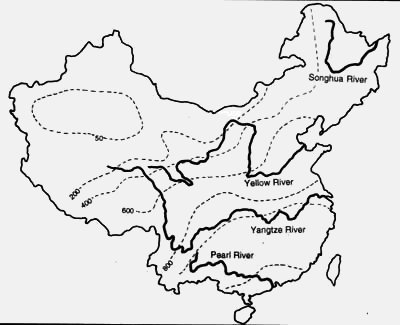Hist 410 Food in Chinese Culture
Keynotes 1
I.
Basic
conditions for food supply:
1. agriculture:
productivity through a diverse farming system
2.
Structure of traditional society: a. officials
b. farmers
c. artisans
d. merchants
3. ‘feast
or famine’:
high productivity versus
exploitation of tenants by landowners
II.
Basic characteristics
of food consumption in
1.
variety of cuisine
2. importance
of community in food consumption
3. rituals
and ceremonies became institutionalized codes related to honor and status
a.
ritual sacrifices
to deities required high quality offerings (deities were considered to consume
the spiritual qualities of the offerings, the material was then consumed by
the human community)
b.
ceremonies and festivities:
high quality food / special food consumption related to auspiciousness of
events (New Year celebrations; birthdays etc.)
1.
A natural environment of superlatives
- highest mountains – lowest depressions
below sea level



 Manchurian
forest
Manchurian
forest
- monsoon exposure: summer monsoon
rains blown from the Pacific (do not affect Central Asian parts of

- extreme river systems:
a. Northern China: Yellow River flows through loess country [= deposits
of wind blown soil and deposits left by floods; loess contains water well
and therefore is very fertile: yellow soil] (Shaanxi,
Shanxi, and Gansu provinces)
Key food plants: millet, soybeans, cabbage, peaches; borrowed plants:
wheat, maize, sorghum, rice, cotton, sesame. Cultivation of borrowed plants
started at different times in history
Key domesticated animal: sheep
 Cave
dwellings in loess
Cave
dwellings in loess
 Map
of the Yellow River
Map
of the Yellow River
b. In the Central Asian parts of China farming depends on intense irrigation systems, partially arranged below the surface using ground water.
 Karez irrigation system
Karez irrigation system
 Karez system
Karez system
The
 Map of the Silk Roads
Map of the Silk Roads
“NOODLE and BREAD CUISINE”
c.
Key crops: rice with double and triple harvests in the south, wheat, barley,
maize, roots

 Karst
mountains near the Lijiang
Karst
mountains near the Lijiang
“RICE CUISINE”
2. The Neolithic and the dawn of history
 Map
of Neolithic China with the centers of Yangshao and Longshan cultures
Map
of Neolithic China with the centers of Yangshao and Longshan cultures
since 50,000 years ago
human
kind used food as
- nourishment
- for healing purposes
- as sacrificial offerings
6500 – 5000 BCE
Peiligang
culture: millets, pigs, chicken
5000 BCE
Yangshao
culture: Banpo village (near modern
millets, hemp;
pigs, chicken; wild: bamboo shoots, persimmons, walnuts, grass
seeds, pine nuts, chestnuts, mulberries (silkworms); deer; fish, clams, mussels
 preserved
archaeological site of Banpo village
preserved
archaeological site of Banpo village
 Banpo
Banpo
 Amphora used for storing food found in Banpo
Amphora used for storing food found in Banpo
 Basin found in Banpo decorated with a mask design and a fish
Basin found in Banpo decorated with a mask design and a fish


4000 BCE
large farming
villages; food preparation: boiling, roasting, steaming
Beginnings of agriculture:
Incentive for
cultivation / domestication: determine the location and seasonal availability
of food; surplus production for trade where possible;
3500 BCE
- introduction of wheat
and barley
2500 BCE
- domestication
of water buffalo as work animal
-
first water conserving techniques developed
- society
structured, end of egalitarian village communities: social organization
advanced to
landowners and tenants
Xia dynasty (?)
Shang dynasty: ca. 1766-1122 BCE
-
cities, several
capitals; capitals were moved according to political necessities
-
elaborate funerals
with human sacrifices for kings
 Royal tomb in Anyang
Royal tomb in Anyang
-
first written documents:
characters engraved on scapula bones and tortoise
shells for divination (hunting, astronomy, warfare, pregnancy of a queen etc.)
 Oracle bone with inscription
Oracle bone with inscription
-
Shang foods: millets,
rice, wheat, barley, chestnut, jujube, apricot; cultivation of mulberry trees
for silk production
- Sacrificial rites related to food were of major importance. Correct
preparation, service and display of food offerings were considered necessary
to appease the deities; elaborate libation ceremonies included vast consumption
of ale/beer (jiu often translated
as wine but made from grains instead of grapes).
 Shang bronze
vessels of types fang, gu, and zun
Shang bronze
vessels of types fang, gu, and zun

 Shang zun in the
form of a ram
Shang zun in the
form of a ram
 Ceremonial vessel
from the Shang shaped like a double owl
Ceremonial vessel
from the Shang shaped like a double owl
- Food divided into categories of ‘fan’ [=
grain foods] and ‘cai’ [= dishes
containing meat
and vegetables; stews]
- Trade in rice and salt (for seasoning
and preserving food)
- Despite the use of bronze for
sacrificial vessels, agricultural tools were still
made of stone, bone,
and wood. Bronze tools were introduced later. Bronze
arrowheads were used as weapons and for
hunting.